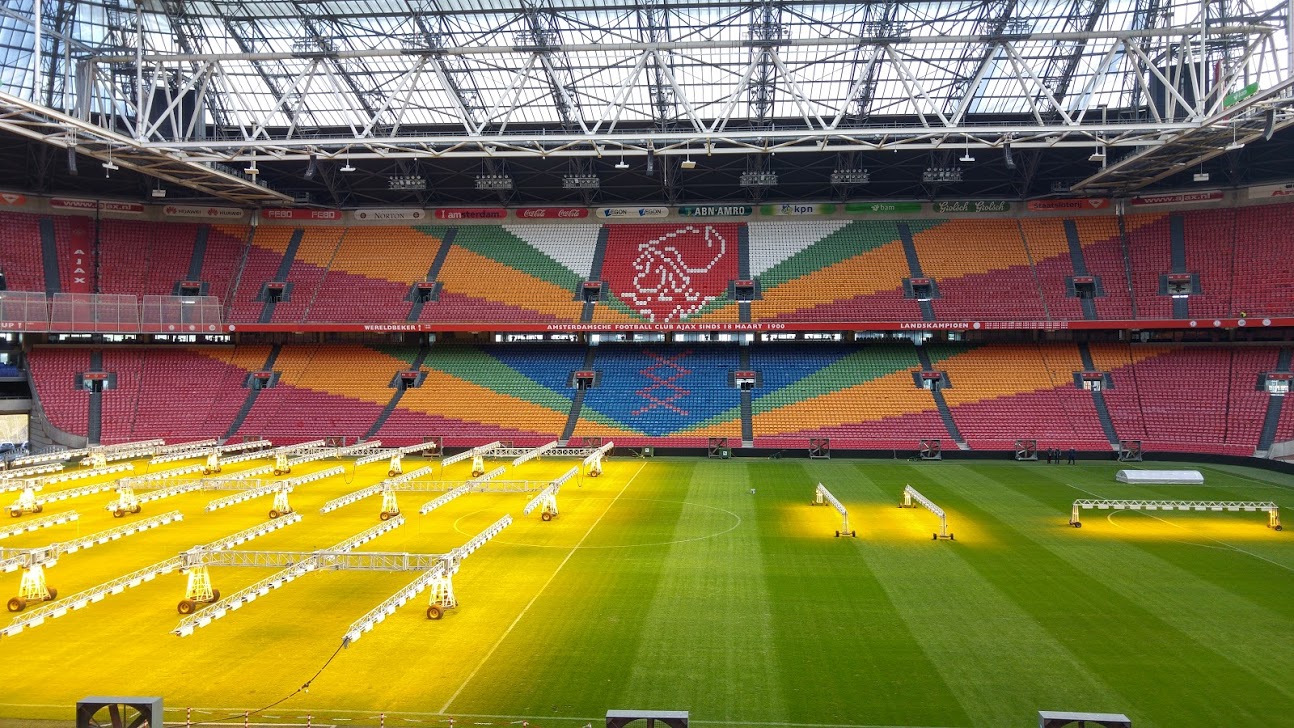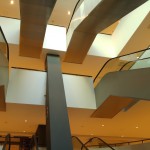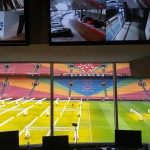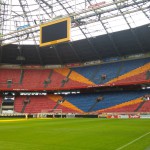
Before leaving the Netherlands last week, we toured Amsterdam ArenA (and yes, that capitalisation is the brand), a relatively new stadium built by a public/private partnership just outside of Amsterdam. This stadium is interesting, not because of the club it hosts (Ajax, pronounced A-yax, is one of the Netherlands’ most popular football clubs) but because of the opportunity that the stadium affords to the tech industry.
You might wonder why we’re talking about a stadium on Ausdroid. Well, we love tech, but we also love to use our tech in the real world, and for many of us, and for many of our readers, we enjoy live sport and better yet, we enjoy the ability to tweet about it and share photos while we’re there. In some ways, Amsterdam ArenA is unremarkable; indeed, part of our tour discussed how the stadium was made “cheap” by its concrete construction. If you’ve been to Stadium Australia / ANZ Stadium in Sydney, you’re probably familiar with the style. However, this stadium is arguably rather unique, because the Government of Amsterdam decided to do something kind of unique.
You see, we’re told by Amsterdam ArenA CTO, Martin Wielaart, that the stadium can be viewed as a microcosm of society. A small city, if you will. On a game day, or for a major event, some 50,000 people can fit inside the stadium, and in associated venues around the arena, another 20,000 people could attend. In fact, at peak capacity, approximately 100,000 people could be within the arena precinct, and this population is easily comparable to that of a small city.
So much so, says Wielaart, that the stadium has most of the same demands — waste, safety, transport, cleaning, food and (most relevantly for us) technology and communications. I must admit, I hadn’t really turned my mind to this, despite having spent quite a bit of time in stadia around Sydney, but he’s right.
What can be done with a city on small scale?
Amsterdam ArenA has taken a unique approach to this situation; instead of believing that any one player can have a monopoly of thought on how this should be managed, the arena’s management have opened the stadium (and its precinct) up to third parties essentially for research and development, so they can test their technologies in a city microcosm without the expense of rolling out such things in a real, actual city.
As you’re probably guessing, being brought on this trip by Huawei, they are one of these partners, but there are others too, including the Netherlands incumbent telco (KPN, their version of Telstra I guess) and more. Some of these partners are doing fascinating things with in-stadium 4G/LTE technology, location services and IoT things, but what Huawei is doing probably has a lot of relevance for any stadium-goer.
Anyone who’s visited a stadium for a major event in Australia can probably tell you that the idea of free stadium wifi is cool, but it’s often lost in the execution. Put 40,000 people or more in one space, have a good proportion connect to the wifi, and it quickly becomes garbage… and better still, there are a multitude of dead-spots around the stadium where the wireless simply can’t reach.
How to do large-scale wifi properly
Amsterdam ArenA appears not to be one of those stadia. On walking through the front door, many of our travelling party connected to the stadium free wifi, and were impressed not only by how quickly we were able to connect (pop in your email address, click submit, and you’re on), but by how quickly the wifi moved data around as well (we saw speeds of around 45-50mbps up and downstream). Of course, Wielaart conceded, these speeds aren’t quite achievable when the stadium is full for an event, but they do come close.

In some recent events with around 40,000 attendees, they’ve observed wifi usage of around 33% (12,000 users during the duration of the event, not necessarily simultaneously) and the high speed, high availability has remained. Huawei has achieved this in partnership with the arena through a number of means, which vary to cater for a number of different scenarios.
Providing for the internal areas is not so much a major challenge, as we are well advanced in indoor wireless coverage, and vendors are familiar with the challenge of router placement to accommodate concrete, metal and others. Some of the bigger challenges come from providing coverage to the seating areas around the stadium.
In the corporate boxes and VIP seating areas, coverage is provided by strategically placed 2.4GHz and 5GHz antenna, and though they are subtle, they are actually quite prevalent. We noticed the benefits, walking through the corporate box and VIP areas that signal was strong, and the speeds remained as fast here as anywhere else.
Providing coverage for the lower tiers of seating was trickier, says Wielaart, as there is quite a distance for wireless signals to travel between antenna and wireless devices — in some instances, well over 35 metres. Though this is largely unobstructed — it’s an air gap, nothing more — the issue isn’t getting the signal to phones, but the return path. Such distance would ordinarily require quite an expending of effort on the part of mobile devices, which leads to a poor experience for users. Their phones go flat rather quickly.
The partnership with Huawei has led to the use of more advanced antenna arrays and more intelligent placement of those antenna; narrow ‘beams’ transmit down to those seating areas, and receive the return path signals, allowing handsets to receive better signal and spend less energy blasting the return signal back up. The winner in this is the stadium goer; the wifi experience remains fast and stable, regardless of how much you pay for your ticket or where you sit.
It seems simple; providing good quality wifi to your visitors doesn’t sound like rocket science, but there is a lot of intelligence and planning that goes into making this happen behind the scenes, and we saw that first-hand today.
It doesn’t stop there
Amsterdam ArenA isn’t content to stop there, though. The stadium already uses anonymous data to measure where people are around the stadium (you needn’t connect to the wifi for this to occur, only have your phone’s wifi turned on) and to generate a heatmap of sorts which is rather accurate. However, they have plans to take this further. Wielaart says that in time, using this technology they will be able to pinpoint the location of staff (he gave the example of security staff) within a 5 metre margin of error, so that more intelligent deployment of resources can be made. Privacy law here prevents this from being used with members of the public, he is quick to add, but the opportunities this allows the stadium with employees are many.
In all, the visit to Amsterdam ArenA was eye opening; it isn’t often you get a behind the scenes tour of a stadium, taking in the pitch itself, the control centre, the press room, the tunnel, and everything in between, and a unique look at how the technology works in an environment like this has been very educational.
There’s a link with Australia in all this too. While we’re seeing this in the Netherlands, Huawei is using this same technology — and the expertise it has developed here — to provide the same kind of service in Australia too. The Gold Coast Suns home stadium, Metricon Stadium, features the same technology (on a slightly smaller scale) to give fans a connected match-day experience. We can’t wait to take a closer look, and better, to see this technology hopefully come to other major stadia too.
This writer travelled to the Netherlands as guest of Huawei.









+1 for article….i wish they will even provide a charging point under each seat 🙂
battery banks are here for a reason 🙂